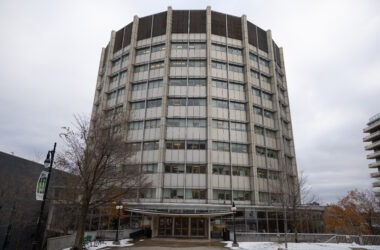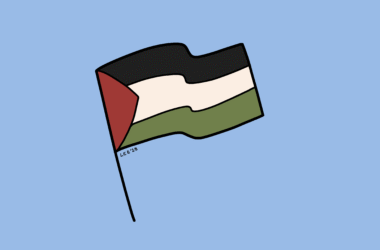McGill’s Media Relations Office (MRO) confirmed in a written statement to The Tribune that from Oct. 23 to Oct. 30, McGill raised the Kanien’kehá:ka (Mohawk) Unity Flag to celebrate the newly-unveiled Tsi Non:we Onkwatonhnhets project at the university’s Y-Intersection. Designed by artist Louis Karoniaktajeh Hall in the early 1970s, the Unity Flag depicts a man in profile against a red background and a sun, wearing one feather in his hair.
Despite The McGill Reporter stating that the Unity Flag on campus represented McGill’s “ongoing partnership with Indigenous communities,” Tekarontakeh, a knowledge keeper of the Kanien’kehá:ka from Kahnawà:ke, reported that he was not informed of the flag’s display at the university, despite being a member of the Rotisken’rhakéhte (Mohawk Warrior Society) who first used this banner.
In an interview with The Tribune, Tekarontakeh contextualized the significance of the Unity Flag for Mohawk communities. He made sure to distinguish the Unity Flag from another iteration of Karoniaktajeh’s work, colloquially known as the “Warrior Flag,” which depicts a man with three feathers in his hair, rather than just one.
“[Karoniaktajeh] put [the Unity Flag] together because he wanted Native people [to] have a symbol […] to help to bring our people back together,” Tekarontakeh explained. “The reason he put only one feather in the [man on the flag’s hair] is to symbolize […] that we are one people. Even though we speak different languages, […] we’re all saying the same thing [….] We are all part of creation [….] What is being done to one is being done to all of us.”
Tekarontakeh also touched on the importance of the Unity Flag’s creation and original use. It was initially employed when Indigenous communities across Turtle Island were fighting for land sovereignty, particularly during the Mohawk reclamation of Ganienkeh in 1974.
“We used that Unity Flag when we went and reoccupied lands in the Adirondack Mountains so that we could build a new community and not live under the Indian Act or Canadian law, or [United States] federal Indian law, or the [United States] Constitution,” he stated. “We wanted to live in accordance to who we are, and we asserted our right to do this [….] We made the choice that we would physically, politically, spiritually, do what we must do in order to ensure that there [would] be a future for our children.”
Today, the Unity Flag acts as both a specific Mohawk symbol of pride and existence and a broader, global sign of resistance against colonialism, oppression, and genocide. Tekarontakeh referred to the flag as a “psychological medicine”—an antidote to actions like McGill’s against Indigenous communities, both locally and internationally.
“McGill University […] did experiments on Native children,” he stated. “McGill was involved in working with the [Canadian] government to assimilate our people, [and McGill is] still a corporation [who has] made money [through] the exploitation of people’s lands.”
Tekarontakeh further referred to McGill’s decision to uproot a white pine tree from the Lower Field in November 2024 as reflective of the university’s ongoing colonialism. Kanien’kehá:ka women planted the tree during a Haudenosaunee peace ceremony in solidarity with the pro-Palestinian Encampment at McGill. The university removed the tree within a day of its planting.
“This tree was a symbol of the people about unification,” Tekarontakeh emphasized. “The question should be asked of McGill, ‘If you’re going to fly that flag, are you prepared to plant that tree back?’ Because they go together.”
Tekarontakeh emphasized that he does not disagree with the flag being flown on campus—as long as it is flown with true awareness, care, and sincere desire to do right by the Indigenous communities McGill continues to exploit.
“If [the] flag is being raised by people who truly support and respect that flag, I don’t have a problem,” he stated. “But if McGill is going to be raising that flag to try to pretend that they care about our people, I think that’s wrong [….] [The Unity Flag should not just be flown at McGill] to give the impression to Mohawk students or Native students [that], ‘Hey, look, we support you.’”
In an interview with The Tribune, Philippe Blouin, a PhD candidate in McGill’s Department of Anthropology and an associate of the Kanien’keha:ka Kahnistensera (Mohawk Mothers) fighting McGill for access to potential unmarked Indigenous graves at McGill’s New Vic site, described McGill’s performativity in flying the Unity Flag.
“It seems like cultural appropriation,” Blouin stated. “If you’re just [displaying] symbols, without any true means for reparation of [simultaneous] historical harm, that’s cultural appropriation [….] [McGill is] actively fighting against members of the traditional families that are represented by that flag.”
In a written statement to The Tribune via the MRO, McGill’s Office of Indigenous Initiatives (OII) affirmed that the Unity Flag was erected in collaboration with Indigenous individuals and groups from the McGill community and the Greater Montreal Area.
“The redesign of the Y-Intersection, along with all planning for its launch, was guided by an Indigenous Advisory Committee,” the OII wrote. “The flag included in the Y-Intersection event and installation was chosen as a gesture of respect and acknowledgment of our host and most proximate First Nation of Kahnawà:ke.”
Blouin shared in a written statement to The Tribune that, according to his Kanien’kehá:ka associates, proper representation of Kanien’kehá:ka symbols such as the Unity Flag at McGill requires more consultation with, and consensus from, the community where the flag originated.
“My associates say it’s really not a matter of criticizing the choices of other community members [who participated in flying the flag], but insisting that the flag being raised at McGill does not reflect an endorsement from the community, but remains a private initiative,” he wrote.
Tekarontakeh expressed hope that McGill and other colonial actors will start to honour their stated commitments to Indigenous communities such as the Kanien’kehá:ka. He shared that the Unity Flag is a way to reaffirm and celebrate Mohawk survival and identity for Kanien’kehá:ka communities and their proven allies.
“[The Unity Flag] is showing the world that we are not extinct,” he affirmed. “Even [when] Canada [tries] to pass laws to legislate us out of existence, […] we will continue to maintain who we are and to pass this on to our children [….] We are still prepared to work towards harmonization of all peoples [….] We’re alive. We can still tell the truth.”









